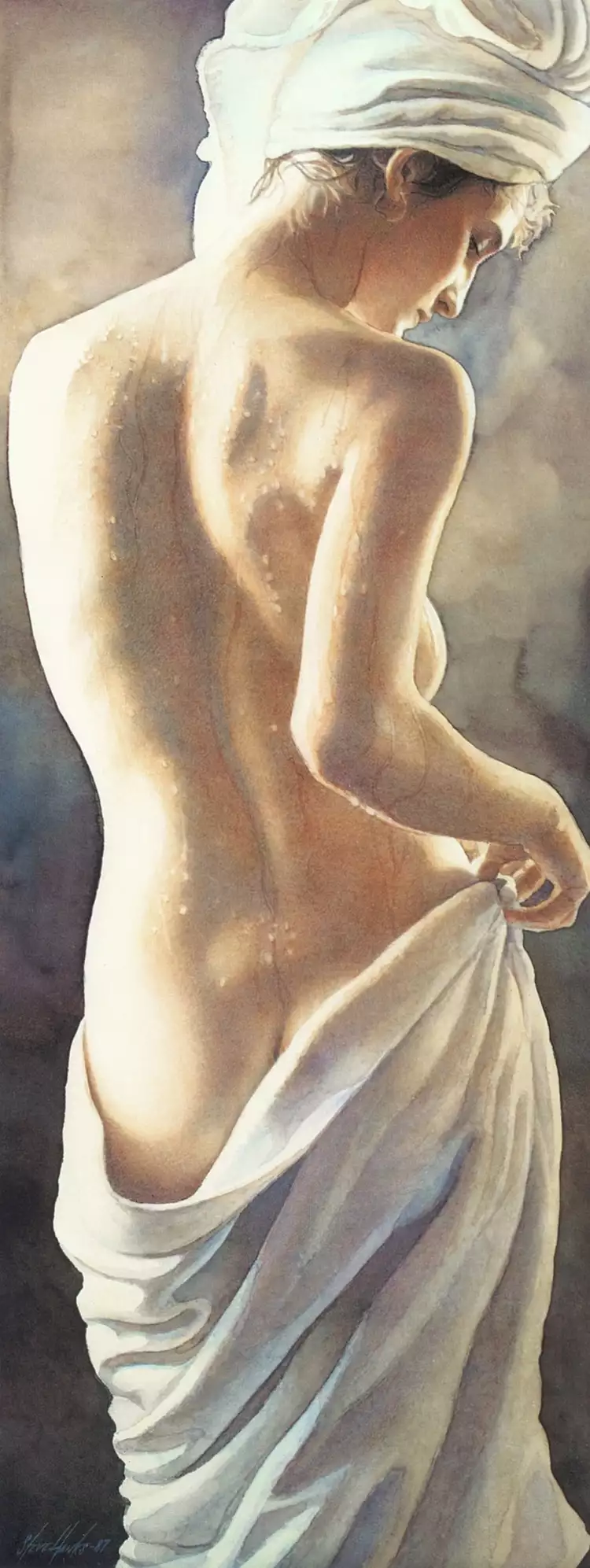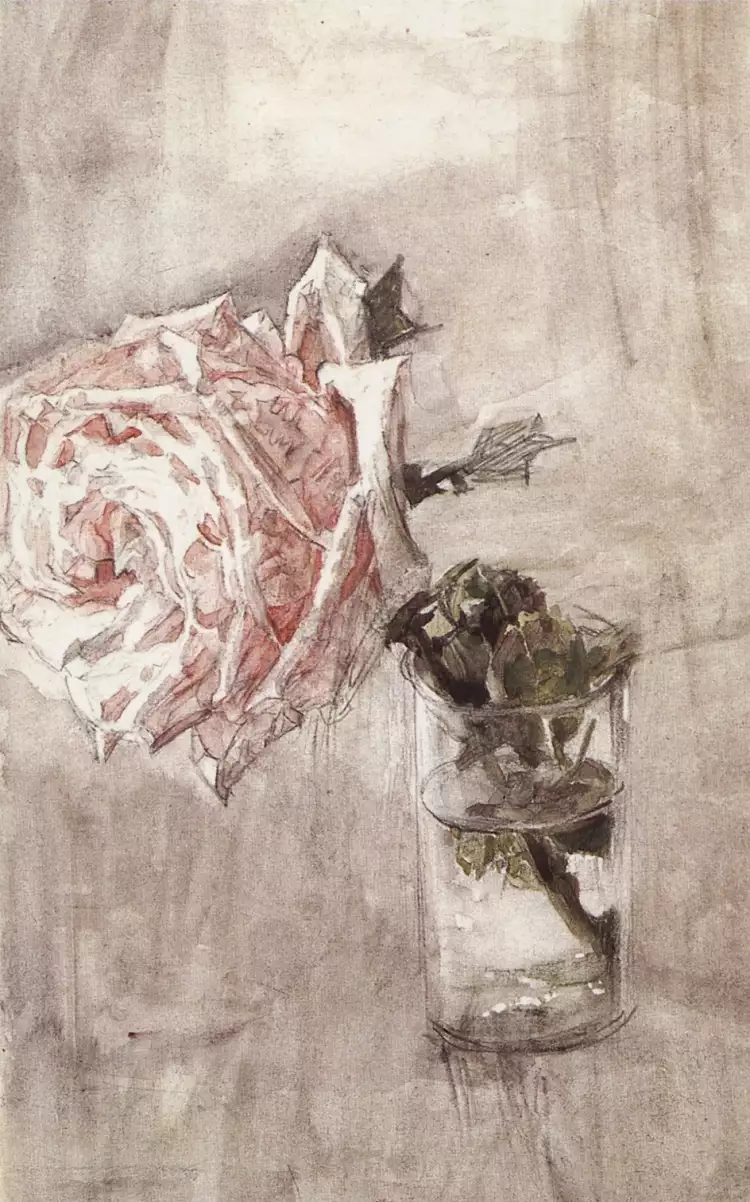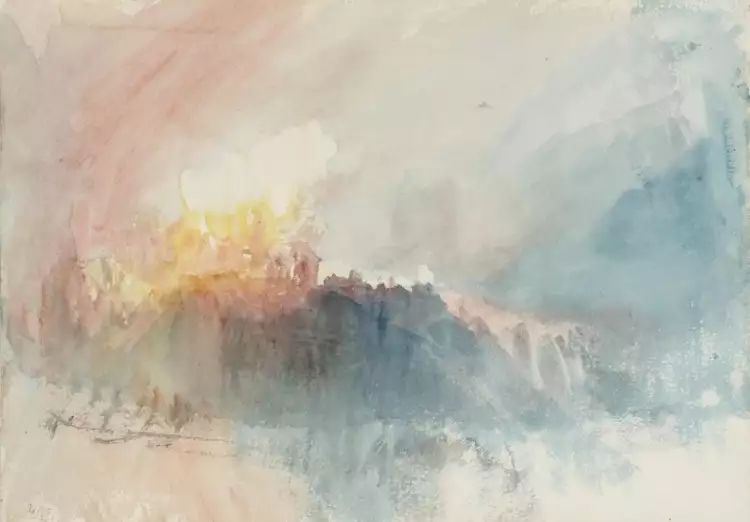
Watercolor - the airy lightness of the rainbow: types, techniques, history
Watercolor is a form of visual art that combines the properties of painting and graphics. From painting, it takes the richness of color and its broad artistic possibilities for shaping forms. From graphics, it takes the thin application of paint (without relief) and the use of paper not just as a material but as an element of representation: the background becomes space, air. Watercolor works are more three-dimensional than graphics but airier than paintings. This technique originated in ancient China in the 2nd century with the invention of paper. Classical European watercolor emerged in the 15th-16th centuries and flourished in England at the turn of the 18th-19th centuries.
 Watercolor. Mikhail Vrubel. Flowers, turn of the 19th and 20th centuries
Watercolor. Mikhail Vrubel. Flowers, turn of the 19th and 20th centuries
Watercolor is a term that reflects the essence of this technique. Artists use special watercolors that are diluted with water before application, not oil paints. Additionally, the paper is sometimes moistened before painting. Hence the name - from the Latin word "aqua" (water). In Italian and French, this gave rise to the terms "acquarello" and "aquarelle."
 Watercolor. Lin Ching Che. Night city. Rain, 2000s
Watercolor. Lin Ching Che. Night city. Rain, 2000s
Watercolor allows artists to expressively convey the effects of airiness and moisture. For a long time, painters struggled with the problem of depicting rain in their works, and this challenge was successfully solved by watercolorists. This technique is ideal for landscape artists working en plein air.
 Watercolor. Konstantin Kuzema. Melodies of St. Petersburg, 2002
Watercolor. Konstantin Kuzema. Melodies of St. Petersburg, 2002
Its capabilities are widely used in portraiture and still life.
 Watercolor. Alexander Bryullov. Portrait of Natalia Goncharova (Pushkina), 1831-1832
Watercolor. Alexander Bryullov. Portrait of Natalia Goncharova (Pushkina), 1831-1832
Types of watercolor techniques
Watercolor combines many interesting techniques. Art historians classify them according to various principles, including the wetness of the paper and brush, and the layering of color. By combining these approaches, we get the following detailed classification of watercolor types:
Dry on dry paper - provides control over the paint. This type of watercolor is also called "Italian." It has two subtypes.
 Watercolor. Steve Hanks. After the shower, 1987
Watercolor. Steve Hanks. After the shower, 1987
Single layer. This artistic approach can be divided into:
- Dry on dry work (meaning the image is applied with a dry brush). This results in very clear strokes, and the work closely resembles graphics.
- Wet on dry work. With a wet brush, the artist applies strokes side by side, slightly overlapping the boundaries. Shades are mixed, creating expressive transitions.
Multi-layer (glazing). The watercolorist applies transparent strokes on top of the dried ones to avoid mixing. This approach brings watercolor closer to oil painting, allowing for very realistic works. The colors are intense and full, but the sense of lightness is preserved.
 Watercolor. Steve Hanks. Sandcastles, 20th century
Watercolor. Steve Hanks. Sandcastles, 20th century
Working on wet paper - this is the so-called English watercolor. Controlling the paint can be challenging, but the artist achieves transparent shades with delicate and soft tonal transitions. There are two variants:
- Wet on wet - provides a strong blurred effect.
- Dry on wet - allows for better control over the paint.
Sometimes the A la Prima method is highlighted, which implies that the work is done in one sitting without further modifications until the material has dried. A la Prima works look fresh and emotional. They cannot be copied as it is impossible to replicate the blur exactly.
 Watercolor. Lin Ching Che. Rain, 2000s
Watercolor. Lin Ching Che. Rain, 2000s
A combination of English and Italian techniques in a single work is also possible. The mixed technique allows for various effects, such as detailed rendering of reality with the blurring of the background.
Drawing on a partially moistened sheet also produces interesting effects. For example, when making a long stroke, a watercolorist obtains different details on dry and wet fragments.
In all four main variations (Italian, English, mixed, with partial moistening), you can work with both a dry brush and a wet one. Additionally, a semi-dry (semi-moist) brush is sometimes used.
 Watercolor. Arthur Fonvizin. Portrait of his wife, early 1940s
Watercolor. Arthur Fonvizin. Portrait of his wife, early 1940s
Paper is not the only material for watercolorists. They also work with silk, parchment, cardboard, ivory, and other materials, although less frequently.
There are mixed watercolor techniques where, in addition to watercolor paints, the following are used:
- Whitewash.
- Pastels.
- Pencil.
- Pen.
- Ink.
- Multiple tools at once.
 Watercolor. Mikhail Vrubel. Rose in a glass, 1904
Watercolor. Mikhail Vrubel. Rose in a glass, 1904
To achieve special effects, watercolor masters also use:
- Salt crystals, which absorb pigment and create miniature local spots and streaks.
- Black tea - to age the paper.
- Crumpled paper - for a special texture.
- Food wrap - to create the impression of glass mosaic.
- The splatter method, where colorful drops scatter chaotically from the brush.
 Watercolor. William Turner. Rome. Colosseum, 1820
Watercolor. William Turner. Rome. Colosseum, 1820
There is also a classification of watercolors by palette:
- Multicolored (polychrome).
- Two-colored (dichrome).
- Grayscale (monochromatic).
This division is significant due to the emphasis on grisaille - watercolors with a special mood and strong atmospheric quality. The impression is achieved through the finest tonal transitions of black, sepia, and ocher.
The history of watercolor and famous watercolor artists
Water-based paints have been around since ancient times, and in the 2nd century, paper was invented in China. These inventions laid the foundation for watercolor techniques. In Europe, paper was introduced in the 12th-13th centuries, but initially, artists used dense body paints on it. Transparent watercolor emerged later, in the 15th and 16th centuries. At first, only a few artists, such as Albrecht Dürer, who created the famous "Young Hare," worked with it episodically. This was due to the underdeveloped artistic approaches, which led professionals to prefer traditional painting.
 Watercolor. Albrecht Dürer. Young Hare, 1502
Watercolor. Albrecht Dürer. Young Hare, 1502
Watercolor as an independent art form was popularized by English artists at the turn of the 18th and 19th centuries. They revealed to the world a wide range of effects that the sister of painting, watercolor, provides to the artist.
 Watercolor. William Turner. Fire of Parliament. View of Westminster Bridge, 1834
Watercolor. William Turner. Fire of Parliament. View of Westminster Bridge, 1834
The pioneers of this school are considered to be Thomas Girtin and Joseph Mallord William Turner.
 Watercolor. Thomas Girtin. Feindlater Castle, 1792
Watercolor. Thomas Girtin. Feindlater Castle, 1792
The best works of watercolor artists have become part of the world's masterpieces. In addition to the aforementioned masters - Dürer, Turner, Girtin - such works were created by:
- Romantic artists Samuel Palmer and Ferdinand Victor Eugène Delacroix.
- Pre-Raphaelite representative Emma Lucy Madox Brown Rossetti.
- Neo-Impressionist Paul Signac.
- Post-Impressionists Paul Cézanne and Maurice Brazil Prendergast.
- Art Brut representative Josef Karl Rädler.
- Scandalous master of the Belle Époque, John Singer Sargent, who is difficult to categorize into a specific movement.
 Watercolor. Eugène Delacroix. Rocks in Normandy, 1849
Watercolor. Eugène Delacroix. Rocks in Normandy, 1849
In Russia, watercolor art was developed by:
- Pyotr Fyodorovich Sokolov (Russian: Пётр Фёдорович Сóколов) (1791-1848).
- Karl Pavlovich Bryullov (Russian: Карл Павлович Брюллов) (1799-1852).
- Mikhail Alexandrovich Vrubel (Russian: Михаил Александрович Врубель) (1856-1910).
- Nikolai Andreevich Tyrsa (Russian: Николай Андреевич Тырса) (1887-1942).
- Valentin Alexandrovich Serov (Russian: Валентин Александрович Серов) (1865-1911).
- Alexander Alexandrovich Deineka (Russian: Александр Александрович Дейнека) (1899-1969).
- Sergey Vasilyevich Gerasimov (Russian: Сергей Васильевич Герасимов) (1885-1964).
- Arthur Vladimirovich Fonvizin (Russian: Артур Владимирович Фонвизин) (1882-1973).
- Sergey Nikolaevich Andriaka (Russian: Сергей Николаевич Андрияка) (born 1958).
 Watercolor. Maurice Brazil Prendergast. Venice. Canal, 1898-1899
Watercolor. Maurice Brazil Prendergast. Venice. Canal, 1898-1899
Today, watercolor works are in high demand among collectors, interior designers, and investors. Watercolor art pieces by various artists from different eras regularly appear at antique auctions. To purchase paintings for your personal collection or as an exclusive gift from a modern watercolor artist, you can directly contact the author using the Very Important Lot website's functionality. Enjoy the selection and explore the various watercolor effects in the paintings of classics and experimenters!
 Giovanni Guida is an Italian artist-innovator and master of grattage
Giovanni Guida is an Italian artist-innovator and master of grattage  Art Nouveau is an international style in the visual arts
Art Nouveau is an international style in the visual arts  Historical Genre in Artists' Paintings
Historical Genre in Artists' Paintings  Lorie Company - silver in the Art Nouveau style
Lorie Company - silver in the Art Nouveau style  Installation - the modern art of striking three-dimensional compositions
Installation - the modern art of striking three-dimensional compositions  The Return of Nature: Embracing Nature Renewal Art in 2024
The Return of Nature: Embracing Nature Renewal Art in 2024  Orders of Germany - awards of former feudal states
Orders of Germany - awards of former feudal states  Engraving is a captivating art of creating printed images
Engraving is a captivating art of creating printed images  Bold Rebranding: A 2024 Design Trend Shaping Brand Identities
Bold Rebranding: A 2024 Design Trend Shaping Brand Identities  Paul Cézanne: Biography, Artistic Career, and the Artist's Masterpieces
Paul Cézanne: Biography, Artistic Career, and the Artist's Masterpieces